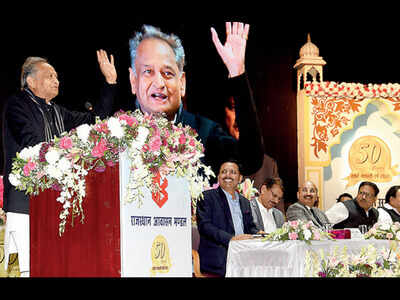
JAIPUR: Jaipur Metro phase-II corridor proposed between Ambabari and Sitapura, which was scheduled to run partially underground, will be entirely elevated.
To reduce the cost of the Rs 13,000-crore project, Delhi Metro Rail Corporation (DMRC) has proposed to construct approximately 23-km corridor overground.
Sources said the DMRC had prepared the revised DPR, which is likely to be forwarded to the state government this week. The approval of detailed project report (DPR) will be made in the state cabinet meeting.
The project cost is expected to be reduced to half if it is elevated. “Now, we have proposed to construct an elevated corridor on major part of the route. While construction cost of an elevated corridor is Rs 200 crore per km, it goes up Rs 550 crore per km underground,” said a senior Jaipur Metro Rail Corporation (JMRC) official.
In the DPR prepared in 2014, it was mentioned that project required land worth Rs 2,000 crore. “It would require less amount than mentioned in the previous DPR. The estimated cost for acquiring land will be reduced to Rs 800,” said a source
The official further said Metro stations, which will be constructed under the Jaipur Metro Phase-II, will not be lavish and spacious as the existing ones. JMRC has proposed to construct small structures, which would occupy less land and need less funds. The decision was taken after taking a cue from Delhi and Chennai. To bring the cost down, suggestion to run three coaches has been also been proposed.
“Many cities in past adopted rationalisation method during the construction of new Metro projects. In Jaipur too, few ways including reducing width of the viaduct by 15%, cutting down length of Metro stations, reducing size of the two Metro rail depots and outsourcing fare collection system are proposed,” said a JMRC official.
After the change in regime, hope of launching the Phase-II project has revived as Metro was the pet project of chief minister Ashok Gehlot in his previous tenure. The JMRC prepared its first DPR in 2011 during the Congress government’s tenure.
To reduce the cost of the Rs 13,000-crore project, Delhi Metro Rail Corporation (DMRC) has proposed to construct approximately 23-km corridor overground.
Sources said the DMRC had prepared the revised DPR, which is likely to be forwarded to the state government this week. The approval of detailed project report (DPR) will be made in the state cabinet meeting.
The project cost is expected to be reduced to half if it is elevated. “Now, we have proposed to construct an elevated corridor on major part of the route. While construction cost of an elevated corridor is Rs 200 crore per km, it goes up Rs 550 crore per km underground,” said a senior Jaipur Metro Rail Corporation (JMRC) official.
In the DPR prepared in 2014, it was mentioned that project required land worth Rs 2,000 crore. “It would require less amount than mentioned in the previous DPR. The estimated cost for acquiring land will be reduced to Rs 800,” said a source
The official further said Metro stations, which will be constructed under the Jaipur Metro Phase-II, will not be lavish and spacious as the existing ones. JMRC has proposed to construct small structures, which would occupy less land and need less funds. The decision was taken after taking a cue from Delhi and Chennai. To bring the cost down, suggestion to run three coaches has been also been proposed.
“Many cities in past adopted rationalisation method during the construction of new Metro projects. In Jaipur too, few ways including reducing width of the viaduct by 15%, cutting down length of Metro stations, reducing size of the two Metro rail depots and outsourcing fare collection system are proposed,” said a JMRC official.
After the change in regime, hope of launching the Phase-II project has revived as Metro was the pet project of chief minister Ashok Gehlot in his previous tenure. The JMRC prepared its first DPR in 2011 during the Congress government’s tenure.
Trending Topics
LATEST VIDEOS
City
 Thane: Two youths suspected of mobile theft beaten up, stripped naked and made to walk
Thane: Two youths suspected of mobile theft beaten up, stripped naked and made to walk  UP: Bhubaneswar bound express train decouple twice, sending passengers into tizzy
UP: Bhubaneswar bound express train decouple twice, sending passengers into tizzy  Sexual misconduct: Another nun accuses Kerala's Bishop Franco Mulakkal
Sexual misconduct: Another nun accuses Kerala's Bishop Franco Mulakkal  UP govt plans to auction over 3000 tonnes of gold reserved in Sonbhadra mine
UP govt plans to auction over 3000 tonnes of gold reserved in Sonbhadra mine
More from TOI
Navbharat Times
Featured Today in Travel
Get the app





